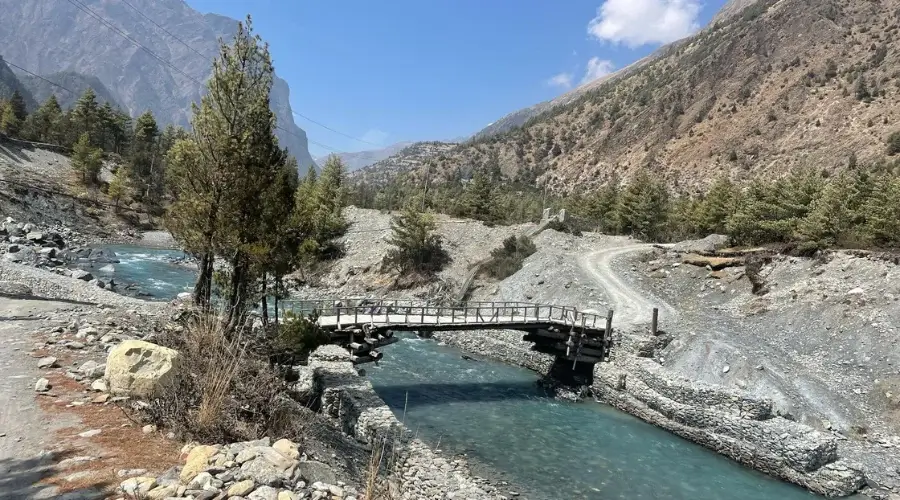
Annapurna Circuit Trek, 11 Days Itinerary
The Annapurna Circuit Trek Nepal ranks as a legendary trekking route in the world. Foreigners have used this trail for more than five decades, and the Annapurna Circuit continues to be Nepal’s most well-known trekking route. Most will select the traditional Annapurna Circuit adventure when asking trekker enthusiasts about their top Nepalese trek choice.
The Annapurna Circuit Trek traverses through an entire circuit surrounding the Annapurna Mountain range. The 160–230-kilometre path of the Annapurna Circuit can be completed within 11 days.
Multiple mountain ranges, including Annapurna peaks, Dhaulagiri and Machhapuchhare, are visible while hiking the Annapurna Circuit Trek Route, and its course takes you through lowland villages, mountains, forests and fields. The trekking route provides mountain rest spots through several neighbourhood tea houses.
Visitors travel to this territory because the famous Annapurna Circuit trail circles each of the majestic peaks. Travelers experience extensive satisfaction upon reaching the highest elevation of Thorong La, which stands at 5,416 meters/17769 feet above sea level. The ascent involves primarily walking forward toward the summit of a mountain.
During this trek, one can experience panoramic views of snow-covered landforms combined with traditional settlements and deep canyons. Trekkers from all around the world visit the Annapurna Circuit Nepal to explore the spectacular beauty of these enormous mountains.
History of Annapurna Circuit Trek
Records show the Annapurna Circuit Trek existed numerous years ago. Prince Charles of Britain introduced the Royal Trek route to the public when he crossed the region in 1980. Prior to 1980, the circuit required three weeks to complete.
New motor road development projects shortened the Annapurna Circuit Trek, so the journey lasts 11 to 14 days. The Annapurna Range contains 29 trekking options, making it a premier trekking hub in all of Nepal.
Crossing Thorong La (5416 m): The Ultimate Annapurna Circuit Challenge
The Annapurna Circuit’s highest section and the most challenging segment is Thorong La Pass, which reaches 5,416 meters altitude. At 5,416 meters in elevation, the spot becomes the highest trail for hikers to navigate.
Trekking to Thorong La, highest trekking pass begins at 4 AM, the early hours of the day. A departure before noon helps minimize the powerful wind force that becomes prevalent during mid-day. The entire process of reaching Thorong La requires between four and six hours of climbing.
The path to reach Thorong La Pass gets very steep because it features a mix of rocky terrain and ice. Each trekker needs between 10 to 15 minutes of rest to recover their breathing. Trekkers must properly adapt to high altitude conditions before attempting the climb because it protects against altitude sickness.
The feeling at the summit becomes an unforgettable memory. The strong wind enables prayer flags to dance through the air with their vibrant colours. Snow-covered peaks surround you.
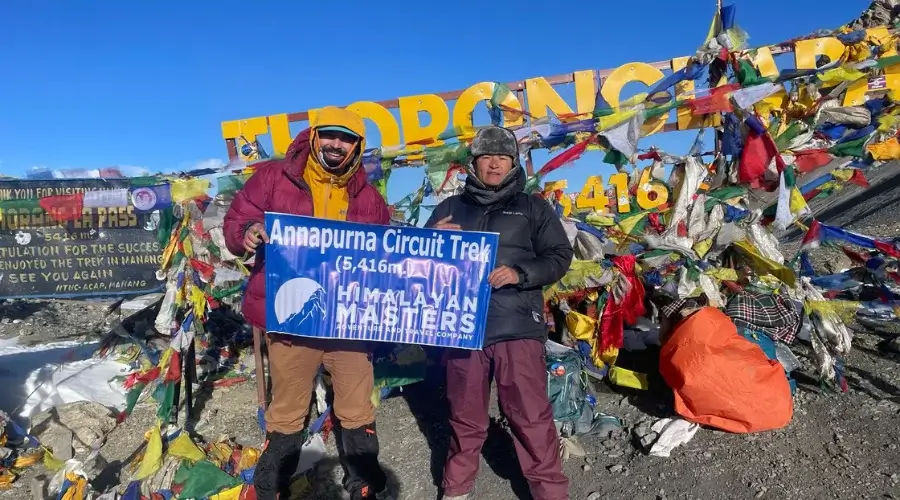
Seeing the Annapurna alongside the Dhaulagiri ranges remains an experience the mind will never forget. Every trekker stays at the pass for 20 to 30 minutes for photos along with celebrating their accomplishment.
The descent is equally challenging. From there, the time required to get to Muktinath amounts to between 3 and 4 hours. The routes present a combination of hazardous conditions, including steep slopes and bad slipperiness.
Trekking poles help a lot. Moving down through the mountain pass brings about denser air that simplifies the process of breathing. Barren hills gradually replace the sections that were once covered in snow.
More than mere physical power is required for success when crossing Thorong La. It’s a mental one, too.
Annapurna Circuit Trek Facts
- Trek Region: Annapurna Region
- Distance of the trek: 160 – 230 km (99 – 143 miles)
- Duration of the trek: 11 days
- Average daily walking time: 5-7 hours
- Difficulty level: Moderate to Difficult
- Trek beginning point: Dharapani (1960 m/6430 ft)
- Trek ending point: Muktinath (3760 m/12336 ft)
- Permits: Trekkers Information Management System (TIMS card) and Annapurna Conservation Area Permit (ACAP)
- Highest elevation on the trek: Thorong La Pass (5,416 meters/17769 feet)
- Accommodation during the trek: Hotel/ Guest House/ Local Teahouses
- Trek cost: 995 USD per person
Trek Highlights
- Conquer Thorong La Pass at the height of 5416 meters/17769 feet.
- Along with the Annapurna range, you can witness Gangapurna, Khangsar Kang, Tarke Kang, Lachenal Peak, Nilgiri Himal North/Central/South, and many more peaks above 6,000 meters.
- A peek into the lifestyle of the Gurung and Magar Community.
- Visit Muktinath, Nepal’s most holy pilgrimage site for Hindu and Buddhist followers.
- Wander into a Sub-tropical forest with vibrant and diverse flora/fauna.
- Trek along the Kali-Gandaki Gorge, the world’s deepest gorge.
- Get a chance to explore the Apple orchid en route the trek.
- Opportunity to taste the local delicacies of the trek like Tsampa, Thukpa, Gundruk, Dhido and Apple wine, rice beer, Tongba, Marpha and much more.
Annapurna Circuit after the 2015 Earthquake
The Annapurna Circuit Trek was affected during the 2015 Earthquake in Nepal, but not like the Langtang Valley Trek and Everest Base Camp Region. The earthquake only affected 1/3 of the trek route. The people and the wildlife were safe during the earthquake in Nepal.
Diverse Culture and Wildlife of the Annapurna Region
Landscapes
The Annapurna region covers a wide range of geographical structures. It extends from one of the deepest gorges in the world, Kali Gandaki Gorge, to one of the highest freshwater lakes, Tilicho Lake.
Kali Gandaki Gorge is 4.8 km (3 miles) in length and 2.4 km (1.5 miles) in width. Likewise, Tilicho Lake is situated at an elevation of 4919 meters (16,138 ft), with 4 km (2.4 miles) in length and 1.3 km (0.8 miles) in width.
The Annapurna Conservation includes Manang, Mustang, Lamjung, Kaski, Myagdi, and the hidden valleys like Upper Mustang, Tsum, and Nar Phu.
The region of Annapurna is home to the world’s 10th highest mountain, Annapurna I (8,091/26,545 ft).
People
The majority of the people in Annapurna are Gurung and Magar in the south and Manange, Loba, and Thakali in the north. Whatever the ethnic community they belong to, a huge portion of people follow Buddhism, while few are Brahmins and Chhetri, who follow Hinduism. You can explore and experience a perfect blend of these communities and soak in their culture.
Wildlife
The Annapurna Circuit Trek goes through the Annapurna Conservation Area. So, you can see a wide range of wildlife. However, due to road construction, the wildlife in the lower region of the Annapurna Circuit trail has been affected.
At higher remote places like Tsum Valley, you can see Himalayan Tahr (a species of wild goat), Goral (another species of wild goat), Pika (a species of rodent), and Himalayan marmots.
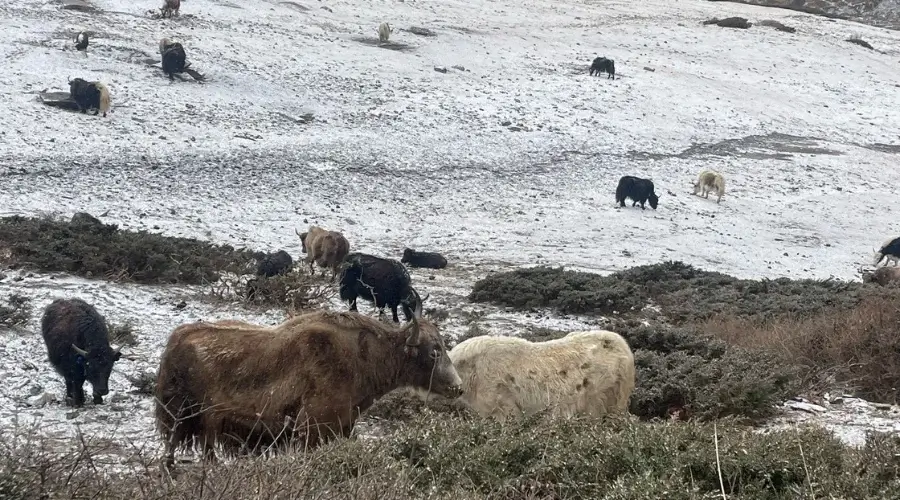
Birds
The Annapurna region is also famous for bird watching. A wide range of predatory birds to beautiful pheasants can be found here. Bulbul, thrushes, parakeets, cuckoos, etc., are some of the small bird species that you might see during the trek.
Wildflowers
The Annapurna Base Circuit Trek has a wide variety of wildflowers that flourish largely during spring and autumn. You can see rhododendrons, orchids, and blue poppies abundantly during the trek. These vibrant wildflowers primarily flourish in higher altitudes, making the region more attractive.
A Typical Day On the Annapurna Circuit Trek
A day’s hike on the classic Annapurna Circuit Trek involves waking up early and having breakfast at the teahouse before setting off from 7 to 8 o’clock. The day of trekking will take hours, leaving only sufficient time for lunch and to view the breathtaking beauty.
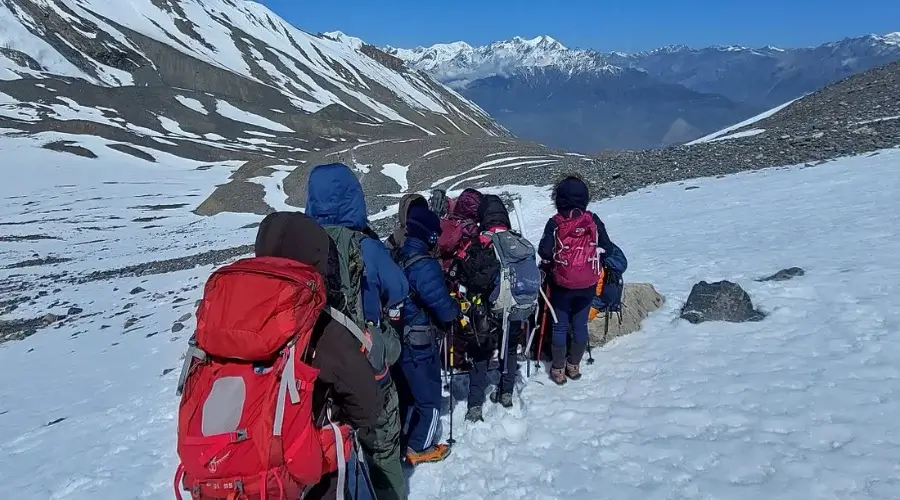
Besides, snacks or light meals are taken during the day, around lunchtime, at a beautiful area on the trail or a teahouse. In the afternoon, you will move to another teahouse, where you can rest, stroll around the region, or even have dinner.
Is This Trek for You?
A question might arise in everyone’s mind before booking the Annapurna Circuit Trek. So, what makes you think you are a perfect fit for the trek or not? If you have some experience in trekking and hiking, then this trek is definitely for you.
Also, keep in mind how many days you prefer hiking. You also need to check your budget and your preferred season type. If these things align with the trek and your preference, then you must go for it.
Important Notes to Remember for the Annapurna Circuit Trek
- Free airport pickup and drop-off on a private vehicle.
- Porters can be shared among trekkers. Hiring an additional porter costs 240 for 11 days.
- Additional fees might be levied for hot showers, Wi-Fi, charging gadgets, hot water, etc.
- You are not allowed to fly a drone in Nepal unless you have special permission from the Nepal government.
- The package does not include snacks, bottled water, beverages, energy bars, dried fruits, or nuts.
- The company offers a complementary cap, water bottle, jacket, and sleeping bag (which needs to be returned).
- You need to follow the instructions from your guide at all times.
- If you experience difficulty trekking, you can inform your trek guide and stop there or descend to a lower altitude.
- Once you book a trip, the money is not refundable. However, your payment is for a lifetime. You can go on a trek anytime you like.
- There are no ATM or card payment services on the trek route, so carry Nepali cash.
- Bottled commercial mineral waters are not allowed on the trek route.
Elevation/Altitude Chart of Annapurna Circuit Trek
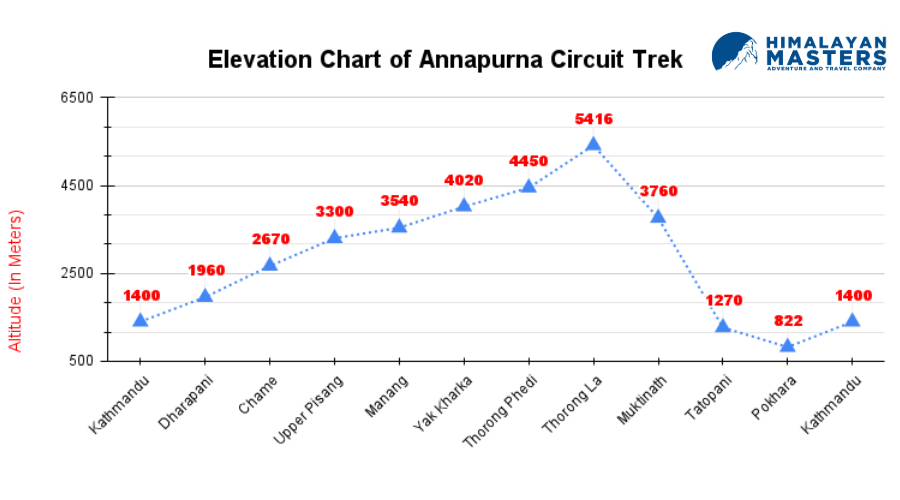
11 Days Annapurna Circuit Trek Itinerary Outline
| Day | Itinerary | Time | Sleep Altitude |
| 01 | Drive From Kathmandu to Dharapani | 8-9 hours | 1960 m |
| 02 | Trek from Dharapani to Chame | 5-6 hours | 2670 m |
| 03 | Trek From Chame to Upper Pisang | 6 hours | 3300 m |
| 04 | Trek From Upper Pisang to Manang | 4-5 hours | 3540 m |
| 05 | Acclimatization Day at Manang- Hike to Ice Lake (4600 m) | 8-9 hours | 3540 m |
| 06 | Trek From Manang to Yak Kharka | 8-9 hours | 4020 m |
| 07 | Trek From Yak Kharka to Thorong Phedi | 4-5 hours | 4450 m |
| 08 | Trek to Muktinath via Thorong La Pass (5416 m) | 8-9 hours | 3760 m |
| 09 | Drive From Muktinath to Tatopani | 5-6 hours | 1270 m |
| 10 | Drive From Tatopani to Pokhara | 4-5 hours | 822 m |
| 11 | Drive From Pokhara to Kathmandu | 6-7 hours | 1400 m |
Annapurna Circuit with Tilicho Lake Trek
Annapurna Circuit Trek with Tilicho Lake Trek is one of Nepal’s most famous and beautiful treks. The trek can start in Dharapani or Manang. The route from Manang will be shorter than the route from Dharapani.
Tilicho Lake is located at an altitude of 4,919 meters. If you want to combine the Tilicho Lake trek with the Annapurna Circuit Trek, then you can complete the trek in around 15-16 days.
Online Trip Briefing with Himalayan Masters
Generally, the trip briefing is done in the Himalayan Masters Office. However, if you need to discuss anything online, we are here to provide you with the required information. You can book the trip once you are clear about the trip details and we know your requirements. Then, we will email you the available dates and itinerary regarding the trek.
Important Note about the Fixed Departure
Your departure from the Himalayan Masters trek to the Annapurna Circuit is 100% assured once you have signed up for it. However, solo travellers will have to pay USD 210 for a single supplement if they cannot find another group member until the date of departure.
Detailed itinerary
Day 01: Drive From Kathmandu (1400 m) to Dharapani (1960 m)
Drive Route: Kathmandu → Beshisahar → Jagat → Chyamje → Tal → Dharapani
Beginning Point: Kathmandu (1400 m/4593.17 ft)
Breakfast: At Hotel stayed overnight
Lunch: Muglin
Ending Point/ Overnight: Dharapani (1960 m/6430 ft)
Kathmandu to Dharapani Road Distance: 250 Km/ 155 miles
Total Ascent: 560 m/ 1837 ft
On the first day of the Annapurna Circuit Trek, we drive west of Kathmandu, heading towards Besisahar. As we drive on the coast of Trishuli River, we stop for breakfast and Lunch.
After we cross Muglin, we follow the trail of the Marsyangdi River up to Besisahar. This beautiful town is the headquarters of the Lamjung district. It takes 5-6 hours to reach Besisahar from Kathmandu.
From here, we hop into another jeep, which takes us to Jagat. The road is entirely off-road, so only Jeeps and Bolero’s four-wheelers can reach Jagat.
The ride on the off-road will be rather exciting and rewarding, with views of the terrace farm. After travelling for around hours, we reach Jagat in the late evening.
From Jagat, we start the Annapurna Circle Walk, climb above the Marsyangdi River, and reach Tal village. Some of the routes are trekking trails, but most of them are bus roads. We can still reach Dharapani via jeep, but as this is a trekking route, we will trek towards it.
The beautiful Tal village lies in the Manang region, making it a lovely rest spot for us. On the way, we encounter many stunning waterfalls and canals that entertain us. In the Tal village, we will stop for Lunch.
From there, we move ahead to cross a suspension bridge and make a final steep climb to the village of Dharapani, our destination for the night.
About Dharapani:
Dharapani is also the ending point of the Manaslu Circuit Trek. Dharapani is a small village that consists of 50-100 local houses. Most of the people of this region are Gurung. Most of them are Buddhist. Dharapani consists of ACAP check posts, Police Check Posts, Health Posts, and primary level Schools.
About Teahouses in Dharapani:
- There are around 15-20 teahouses.
- Facilities include a hot shower, Wi-Fi, an attached bathroom, and more.
- You will get fancy to standard teahouses.
Meal : Breakfast, Lunch & Dinner
Accomodation : Guest House
Walking / Driving : 8 to 9 hours driving
Day 02: Trek From Dharapani to Chame (2670 m)
Trek Route: Dharapani → Danakiyu → Timnang → Chame
Beginning Point: Dharapani (1960 m/6430 ft)
Ending Point/ Overnight: Chame (2670 m/8760 ft)
Dharapani to Chame Trek Distance: 15.5 Km/9.6 miles
Total Ascent: 810 m/ 2657 ft
Today’s trek also consists of a road route. Only a few parts of the route are trekking routes. On the way to Chame, you can spot various Jeeps. The route is exciting.
On the third day of the Annapurna Circuit Himalayas Trek, we have a beautiful walking day as we continue following the path made by the Marsyangdi River.
After walking for an hour, you reach Danakiyu, where you will find enormous tunnels for Horticulture and floriculture. Various kinds of seeds can be found in the area.
The path is filled with the beauty of pine, fir, and maple trees and various wildlife accompanying them. We enjoy stopping at a natural hot spring for a quick dip on the way.
If you pick the right season for the trek, you can also spot the Lamjung Himal and Annapurna ranges throughout the walk.
After walking for 5-6 hours from Dharapani, you will reach Chame. This significant settlement, also the headquarters of Manang, is our night destination.
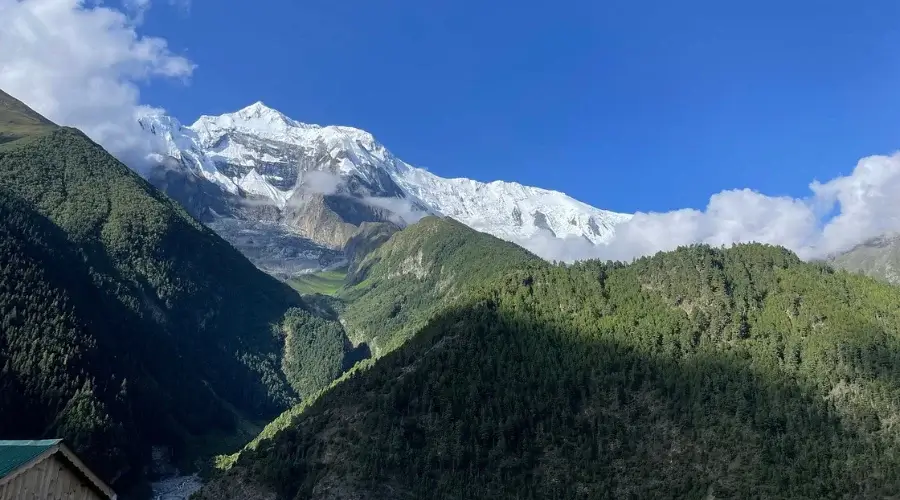
About Chame:
Chame is the headquarters of the Manang district. It has several governmental-level offices, including a District Administrative Office, Hospitals, Schools, and large infrastructures. The area consists of 100 local houses. Most of the people are Gurung and Manangi. They are influenced by Tibetan culture and follow it, too.
About Teahouses in Chame:
- There are 20-30 teahouses.
- Teahouses have Wi-Fi, a hot shower, electricity, and excellent accommodations.
- But you need to pay some amount to get these services.
Meal : Breakfast, Lunch & Dinner
Accomodation : Tea House
Walking / Driving : 5 to 6 hours Walking
Day 03: Trek From Chame to Upper Pisang (3300 m)
Trek Route: Chame→ Bhratang → Dhukhur Pokhari → Pisang
Beginning Point: Chame (2670 m/8760 ft)
Ending Point/ Overnight: Pisang (3300 m/10827 ft)
Chame to Pisang Distance: 13 Km/ 8 miles
Total Ascent: 630 m/2066 ft
Today, we will walk for about 6 hours, covering a distance of 13 km.
First, we have breakfast in the morning and walk via the steep valley towards the Bhratang. Bhratang is an area with a considerable apple garden. A vast area is turned into an Apple farm. The area is also known as Talekhu. You can find various apple items in the area, like apple juice, wine, pie, and much more.
Then, we will pass by a big curved rock at 1500m, which the locals consider holy. It is said that nearer to the rock, very reputed Buddhists and lamas were cremated. In simple words, it is a cremation area.
After walking for around 3.5 hours, we will reach Dhukur Pokhari, where we will have Lunch. After Lunch, we will make our way towards Upper Pisang.
After 1.5 hours, we will reach Upper Pisang. As we witness Annapurna II and Pisang Peak, which are very close to us, this is a perfect time for some photoshoots.
About Pisang Village:
Pisang is also a tiny village with a famous monastery. From Pisang, you can see the majestic Annapurna Range and Tilicho Mountain. About 50-60 local people’s houses can be found in the area. There is also a viewpoint in the area from which you can see the majestic views of the mountains.
About Teahouses in Pisang:
- There are around 10-15 teahouses in Pisang.
- The teahouses have every basic service and facility that a person requires during the stay.
Meal : Breakfast, Lunch & Dinner
Accomodation : Tea House
Walking / Driving : Around 6 hours Walking
Day 04: Trek From Upper Pisang to Manang (3540 m)
Trek Route: Pisang → Ghyanu → Naol → Tyangki → Manang
Beginning Point: Pisang (3300 m/10827 ft)
Ending Point/ Overnight: Manang (3540 m/11614 ft)
Pisang to Manang Distance: 19 Km/11.8 miles
Total Ascent: 240 m/787 ft
There are two ways to reach Manang: via the airport and via Ghyanu. We will choose the second route.
Today’s route is flat along the ridgeway and sloppy at the end. After walking for around 3.5 hours, we will reach Naol, where we will have Lunch. Our destination today is a very welcoming and warm place.
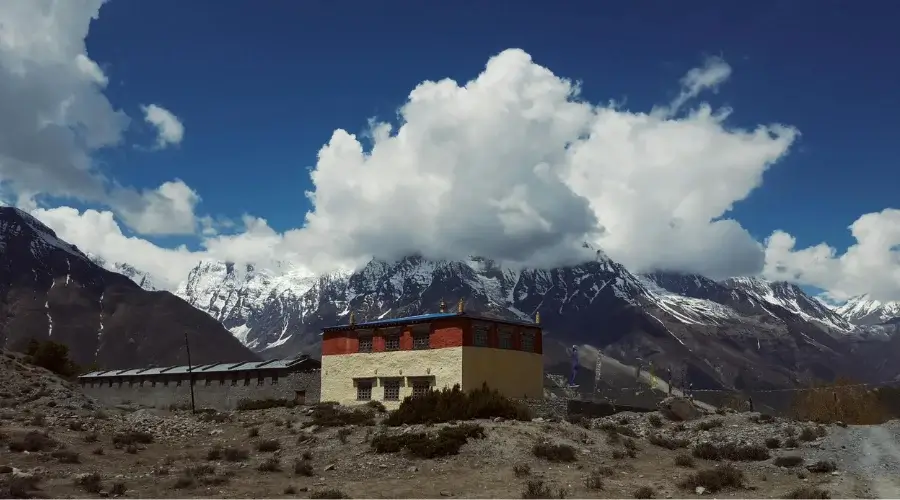
About Manang:
Manang is a beautiful town with a huge population compared to other villages on the way. Most of the people in the area are involved in either farming or raising cattle. Many people in the area are Tibetan and Buddhist. Only a few people of other castes reside in this region. There is also an ACAP check post in Manang, a hospital, boarding schools, primary schools, and a vast, vulnerable hospital. About 200 houses of local people can be seen in this region.
About Teahouses in Manang:
- You will find fancy to standard hotels.
- Around 10 best teahouses.
- You will find all the services, including Wi-Fi, electricity, and a hot shower.
Meal : Breakfast, Lunch & Dinner
Accomodation : Tea House
Walking / Driving : 4 to 5 hours walking
Day 05: Acclimatization Day at Manang- Hike to Ice Lake (4600 m)
After many days of tireless walking on the Annapurna Circuit Himalayas Trek, our bodies need some rest. Having a rest day is also essential to cope with the decreasing altitude. It’s your time to emerge into the local culture and explore the beauty of timeless monasteries and museums in the Manang village.
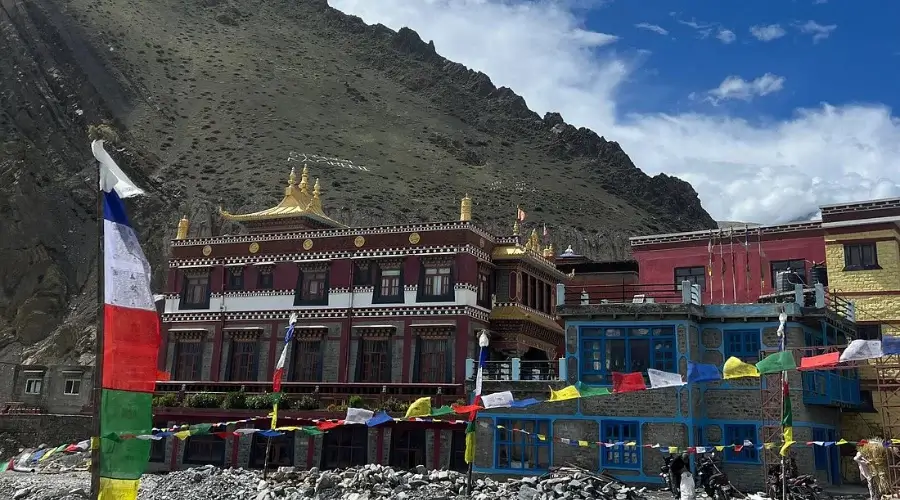
Another option is to explore the lakes in Manang. We will trek up to Ice Lake, located at 5000 meters. The area has no teahouses or huts so that we will have a packed lunch and water. The round trip takes around 8-9 hours. Moreover, it’s the spot for stunning Gangapurna and Tilicho Peak views.
Also, an extension to Tilicho Lake from Manang village is available.
Meal : Breakfast, Lunch & Dinner
Accomodation : Tea House
Walking / Driving : 8 to 9 hours walking (If the Trekkers want to)
Day 06: Trek From Manang to Yak Kharka (4020 m)
Trek Route: Manang → Tyangki → Gunsang → Yak Kharka
Beginning Point: Manang (3540 m/11614 ft)
Ending Point/ Overnight: Yak Kharka (4020 m/13189 ft)
Manang to Yak Kharka Distance: 10 Km/ 6.2 miles
Total Ascent: 480 m/ 1574 ft
Get ready for a fun day of walking. We start the hike after a quick morning breakfast and ascent up to the Tyangki. We walk together with horses and yaks to Gunsang village. As the trek is just five hours, we will have a heavy breakfast and walk until we reach Yak Kharka to have Lunch.
Then, crossing some more suspension bridges, we reach Yak Kharka. As we are already walking at a high elevation, walking slowly and steadily in the mountains is necessary. But the grade is much gentler at this point. The whole afternoon is reserved to explore the nearby viewpoints.
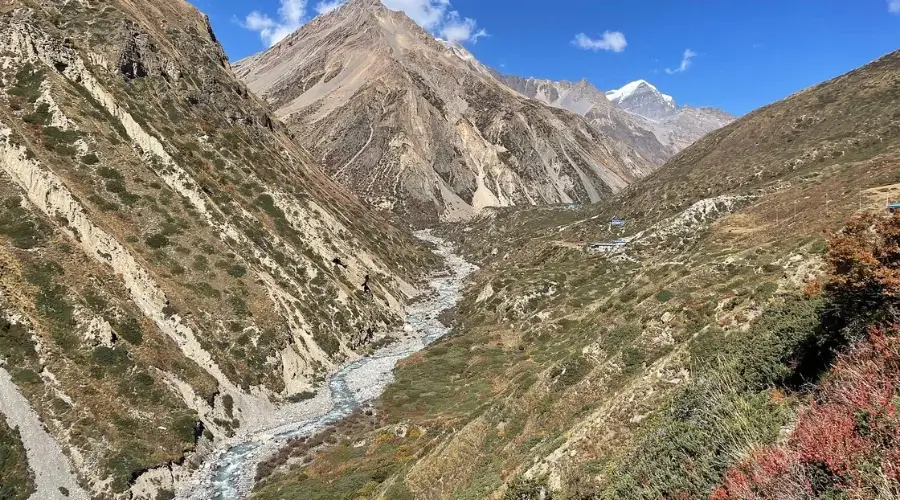
About Yak Kharka:
Yak Kharka is just a teahouse area. The local people run the teahouse.
About Teahouse in Yak Kharka:
- About 5 teahouses in the area.
- You will find services like Wi-Fi, bucket hot showers, and charging, but you have to pay extra for them.
Meal : Breakfast, Lunch & Dinner
Accomodation : Tea House
Walking / Driving : 8 to 9 hours walking
Day 07: Trek From Yak Kharka to Thorong Phedi (4450 m)
Trek Route: Yak Kharka → Ledar → Thorong Phedi
Beginning Point: Yak Kharka (4020 m/13189 ft)
Ending Point/ Overnight: Thorong Phedi (4450 m/14600 ft)
Yak Kharka to Thorong Phedi Distance: Approx. 6 Km/3.7 miles
Total Ascent: 430 m/1410 ft
Today’s trek is another easy walk, lasting about 4 to 5 hours. We will begin our day later in the morning to ensure we are well-rested. The trek will take us across beautiful alpine pastures, leading us to a suspension bridge. We will take our time to enjoy the stunning landscapes and capture some beautiful photographs before arriving at Thorong Phedi.
Thorong Phedi is the base camp for our challenging climb to Thorong La Pass. Here, we will find comfortable lodges and a few bakeries where we can enjoy coffee and snacks. Resting well today is essential for preparing for the demanding trek ahead.
On this day, we will walk according to the trekker’s pace and health. If the trekker is able to walk up to the High camp, we will trek up to the High camp; otherwise, we will stay at the Thorang Phedi only.
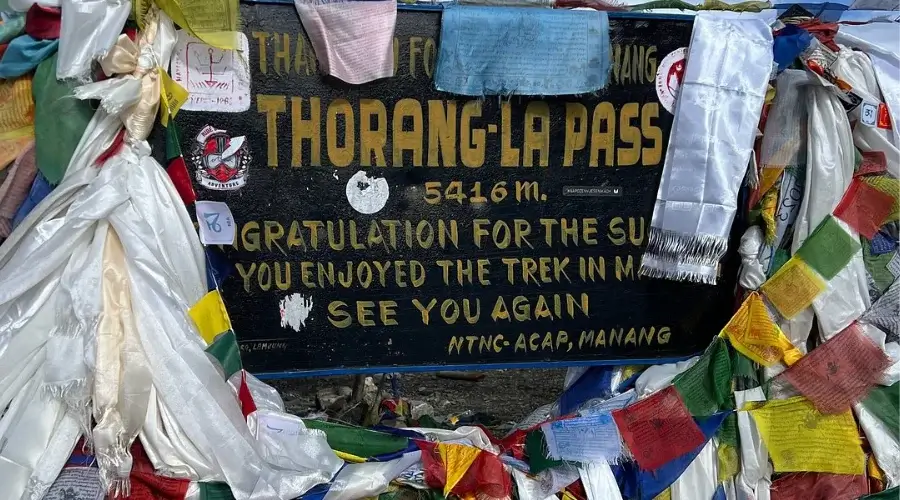
About Teahouses in Thorong Phedi:
- There are only 2 teahouses in the area.
- The area consists of only two teahouses, but the teahouses can accommodate more than 100 people in each one.
- You can only find a bucket, hot shower, Wi-Fi, and electricity, but they could be more reliable. You will need to pay an extra charge for the services.
Meal : Breakfast, Lunch & Dinner
Accomodation : Tea House
Walking / Driving : 4 to 5 hours walking
Day 08: Trek to Muktinath via Thorong La Pass
Trek Route: Thorong Phedi → Thorong La Pass → Phedi → Muktinath
Beginning Point: Thorong Phedi (4450 m/14600 ft)
Ending Point/ Overnight: Muktinath (3760 m/12336 ft)
Thorong Phedi to Muktinath Distance: 15 Km/9.3 miles
Maximum Altitude: Thorong La Pass (5416 m/17769 ft)
Total Ascent: 966 m/3169 ft
Total Descent: 1656 m/5433 ft
We will hike from Thorong Phedi to Thorong La High Pass (5416 m), the highest point of our journey. We will start our ascent early in the morning to reach the pass before the sun rises too high.
This is a crucial part of the trek, and in snowy conditions, trekkers may need gear such as ropes and axes. Once we reach the top, we will enjoy panoramic views of numerous mountains and the Tibetan plateau. We will click some photos and rest there for a while.
Then, we will make our way up to Phedi, where we will have Lunch. After Lunch, we will begin our trek towards Muktinath. It will take around 3 hours to reach Muktinath from Phedi. The route is downhill as the altitude of the region starts to decrease.
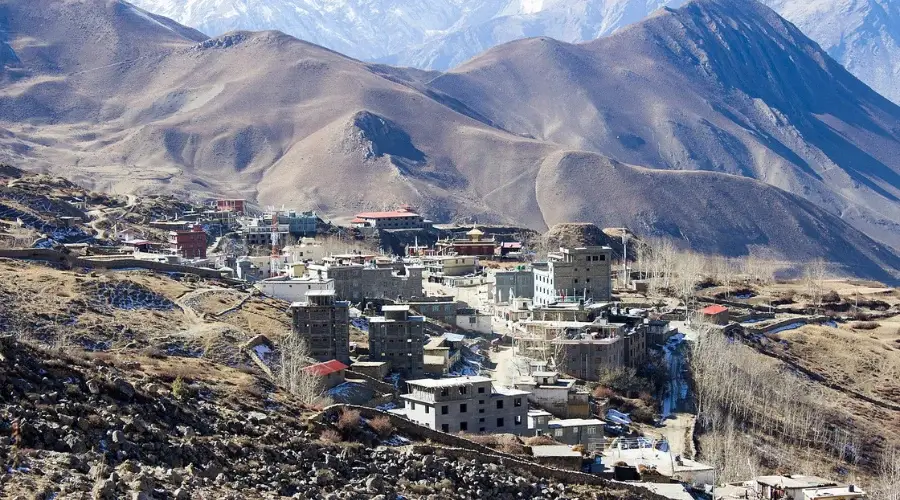
About Muktinath:
Muktinath is a holy pilgrimage site located in the Mustang district of Nepal at an altitude of 3,710 meters. It is significant and spiritually crucial for both Hindus and Buddhists who visit to seek salvation and purification. The temple complex features 108 sacred water spouts, where devotees bathe as part of their rituals.
The local population, primarily engaged in agriculture and tourism, warmly welcomes pilgrims and trekkers.
About Teahouses in Muktinath:
- There are many teahouses in Muktinath.
- You will find very standard and high-rated hotels in the area.
- Every extra service can be found in the region.
Meal : Breakfast, Lunch & Dinner
Accomodation : Guest House
Walking / Driving : 8 to 9 hours walking
Day 09: Drive From Muktinath to Tatopani (1270 m)
Drive Route: Muktinath → Jomsom → Ghasa → Tatopani
Beginning Point: Muktinath (3760 m/12336 ft)
Ending Point/ Overnight: Tatopani (1270 m/4167 ft)
Muktinath to Tatopani Distance: 70 Km/ 43.4 miles
Total Descent: 2490 m/ 8169 ft
In the morning, we visit the Muktinath temple and get her blessing for all our endeavours in life. Then, we hop on a Jeep to drive to Tatopani. We stop at Kagbeni to visit a local monastery and a suspension bridge. Then, in another 15 minutes, we arrive at Jomsom. This headquarters of the Mustang district has some decent results, including a bar and an airport.
After a quick stop, we continued our walk to Tatopani. Now, we leave the enriched Himalayas and their culture behind us.
In the early evening, we find ourselves immersed in the luxury of a natural hot spring. The water is not just hot; it’s full of minerals that will rejuvenate your body after a challenging walk. We crash at a small tea house nearby for the night of the Annapurna trail.
Meal : Breakfast, Lunch & Dinner
Accomodation : Guest House
Walking / Driving : 5 to 6 hours driving
Day 10: Drive From Tatopani to Pokhara (822 m)
Drive Route: Tatopani → Beni → Nayapul → Pokhara
Beginning Point: Tatopani (1270 m/4167 ft)
Ending Point/ Overnight: Pokhara (822 m/2696 ft)
Tatopani to Pokhara Distance: 103 Km/64 miles
Total Descent: 848 m/ 2782 ft
As we approach the final day of the Annapurna trail trek, we plan to drive back to Kathmandu. But before that, we have a quick stop at Pokhara. Today, we leave Totopani and drive to Beni in the morning. From here, a 4 to 5 hour drive on the Highway takes us to Pokhara before mid-day.

We then check into our hotel in Lakeside. Now, you can enjoy boating, sightseeing, paragliding, and other adventurous activities in Pokhara. This beautiful city of lakes is a paradise for vacation and adventure tourism in Nepal. It’s also your chance to get some spas or enjoy the nightlife of Nepal.
You can extend it from Pokhara if you want to trek to the Annapurna Base Camp.
Meal : Breakfast, Lunch & Dinner
Accomodation : Hotel
Walking / Driving : 4 to 5 Hours (Driving)
Day 11: Drive From Pokhara to Kathmandu (1400 m)
Drive Route: Pokhara → Muglin →Kathmandu
Beginning Point: Pokhara (822 m/2696 ft)
Ending Point/ Overnight: Kathmandu (1400 m/4593.17 ft)
Pokhara to Kathmandu Distance: 201 km/125 miles
Total Ascent: 578 m/1896 ft
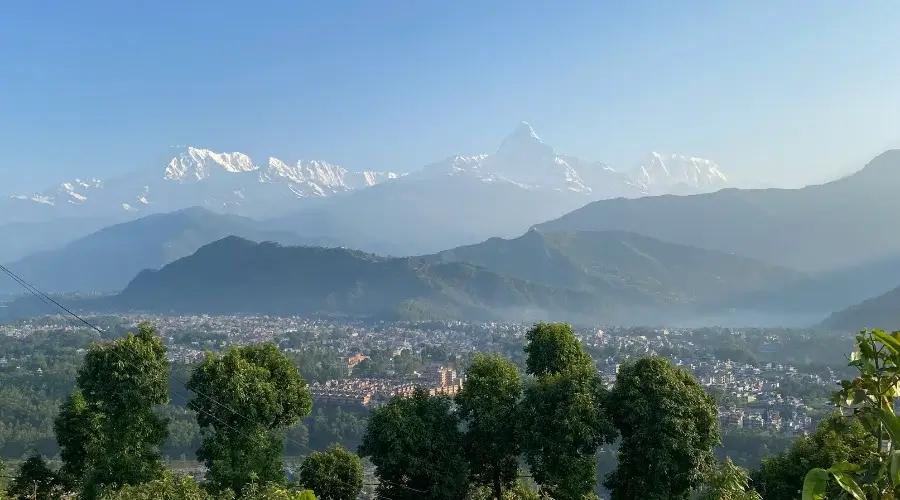
This is your final day of the Annapurna circuit trek. We leave Pokhara after breakfast and drive to Kathmandu. This is the same Highway you drive on the first day of the trick. We stop at the bank of Trishuli River for launch before we drive to the capital city of Kathmandu.
Back at our hotel in Thamel, we all celebrate our victory while Himalayan Masters provide you with a farewell dinner and a certificate of trek achievement.
Meal : Breakfast & Lunch
Accomodation : Not Included
Walking / Driving : 6 to 7 hours driving
Include / Exclude
Trip Cost Includes
- Airport pick-up and drop-off by private car.
- Kathamndu to Besisahar by local bus.
- Besisahar to Dharapani by local sharing jeep.
- All permits are included, like Annapurna Conservation Area permits and TIMS card.
- Professional English-speaking trekking guide as per the itinerary.
- Breakfast, lunch and dinner during trekking days.
- Three cups of tea or coffee a day.
- Twin-sharing private room tea house accommodation during the trekking (We will provide a room with a private bathroom in that village, Dharapani, Chame, Pisang, Manang, and Muktinath).
- Muktinath to Tatopani by local bus.
- Tatopani to Pokhara by local bus.
- One-night, three-star hotel in Pokhara with breakfast.
- Pokhara to Kathmandu by tourist bus.
- Guide and porter insurance.
- All government taxes and company service charges.
Complimentary services from Himalayan Masters
- Himalayan Masters Brand -25°C sleeping bag during the trip.
- Himalayan Masters Brand -25°C Down jacket during the trek.
- A pulse oximeter to monitor your oxygen saturation and heart rate.
- Himalayan Masters brand water bottles.
- A packet of water purification Tablets.
- First aid kit box.
- Seasonal fruits for dessert.
- Himalayan Masters Brand Duffle Bag for the Trek (If you hire a porter).
- Himalayan Masters Brand Trekking T-Shirt and Cap.
- The guide keeps a bottle of oxygen on hand in an emergency.
- Annapurna Circuit Trek Map.
Trip Cost Excludes
- International Flight Ticket.
- Nepal Visa.
- Travel insurance.
- Food and accommodation in Kathmandu.
- Tips for guide and porter.
- One Porter for 11 days, USD 250 (Optional).
- Private Jeep (Optional).
- Lunch and dinner in Pokhara.
- Your personal expenses.
Useful Info
Best Time for Annapurna Circuit Trek
The best time for Annapurna Circuit trekking is when the weather is good and there is little precipitation during spring (March, April, and May). This season is indicated by mild temperatures, clear skies, and blooming vegetation throughout the year.
Another good time to visit the Annapurna Circuit Trek is autumn (September to November). Autumn is the most preferred time for trekking because of the favourable weather, clear visibility, and comparatively low traffic.
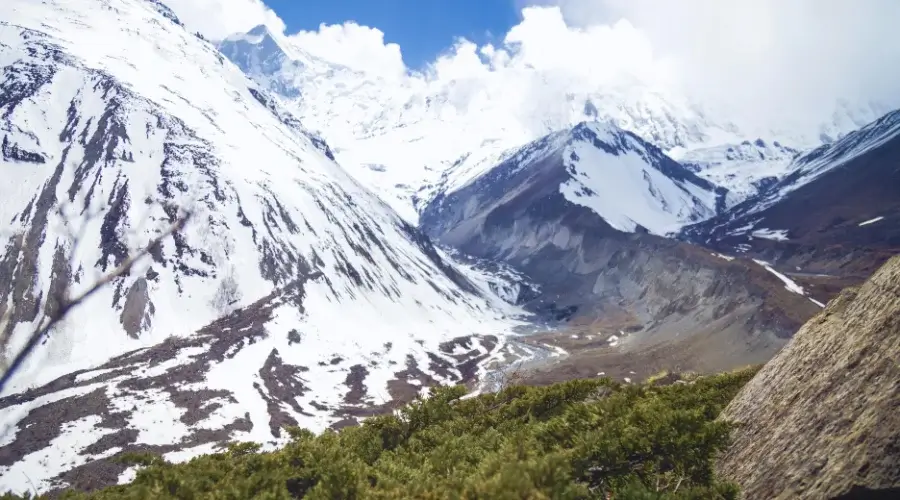
It is advised not to visit during the monsoon season because of the heavy rains, landslides, and low visibility from June to August.
Annapurna Circuit Trek Experience
Although prior trekking experience is preferred, it is optional to have done high-altitude treks before. The Annapurna Circuit Trek involves hiking through different landscapes with steep slopes, surfaces ranging from rocks to gravel, and suspension bridges.
Notably, a certain degree of flexibility and morale can go a long way toward completing the trek. For newcomers to trekking, it is recommended to use the tour services or hire a porter to carry your belongings, making the journey more exciting and accessible.
Annapurna Circuit Trek Weather
The weather in the Annapurna region may change occasionally and even during the day.
The climate is typically mild, with daytime temperatures averaging between 10°C and 20°C in spring and autumn and cooler temperatures, even freezing at times, at night, especially at higher altitudes.
You can expect temporary climate changes and pack the proper clothing and equipment for rain, snow, and wind.
Annapurna Circuit Trek Difficulty
The Annapurna Circuit Trek is moderately difficult due to its altitude, which reaches 5,416m at Thorong La Pass. Altitude sickness is common among trekkers and can start at altitudes above 2,550 meters. It may cause nausea, headache, and tiredness.
The walk is moderate and takes about 5 to 6 hours a day to cover 8 to 15 km or more, which means hikers need to be fit and acclimatized because of the high altitude and less oxygen.
Challenges such as harsh weather conditions and altitude changes, steep and narrow paths, and the chance of sudden altitude changes add to the difficulty of the Annapurna Circuit Trek.
Roads on the Circuit and How to Avoid Them
Despite being a popular trekking area since 1977, roads have been constructed in the region since 1980, causing controversy. Only five days on the Annapurna Circuit route are completely road-free.
To avoid roads on the Annapurna Circuit, hikers can use alternative trails marked by the New Annapurna Trekking Trail (NATT) system. Bike packing the Annapurna Circuit is a unique adventure with a different landscape perspective.
Trip Grade: Fitness Level, Medical, & Health
It is an average moderate to challenging trek, preferably for accomplished trekkers or people with physically active lifestyles. Trekking entails walking five to eight hours a day and, at times, at higher altitudes than usual.
Before the trekking adventure, it is suggested that one undertake cardiovascular exercises, including hiking, running, and biking, for at least 8-12 weeks before the trip.
Correct acclimatization is necessary to reduce the possibility of altitude sickness. If you have had any health issues or problems, it is always a good idea to check with your doctor before you go on the trek.
Altitude Sickness in Annapurna Circuit Trek
Acclimatization, or altitude sickness, is a dangerous disease that may develop in people who quickly climb mountains or go to high-altitude areas. Some symptoms that need to be examined include headaches, nausea, dizziness, and shortness of breath.
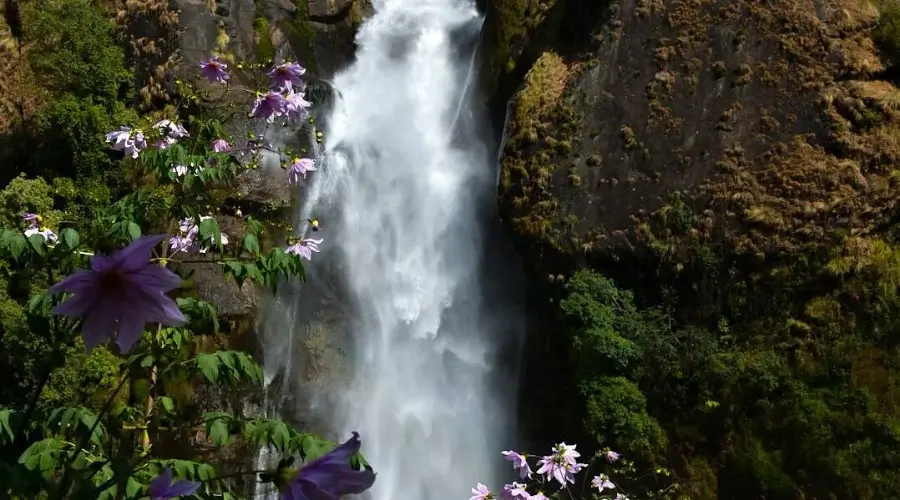
One can take measures to prevent altitude sickness, including climbing gradually at slow rates to avoid a sudden change in altitude pressure. One must also stay hydrated, avoid consuming alcoholic beverages, and take various drugs such as Diamox (acetazolamide) when advised by the doctor.
Emergency and Evacuation in Annapurna Circuit Trek
Local hospitals are available in towns like Manang and Jomsom in case of emergencies or severe medical conditions. Annapurna helicopter evacuations can be arranged, but weather conditions may affect availability.
It’s highly advisable to have complete travel insurance that covers high-altitude trekking and emergency medical expenses, including evacuation costs. Inform your insurance provider about the details of your trek and obtain a policy that meets your needs.
Insurance for Annapurna Circuit Trek
It is always advisable for any trekker to have all-inclusive travel insurance when going on any trek, especially the Annapurna Circuit Trek.
Full insurance, including high-altitude trekking, medical charges, and evacuation expenses, should be taken. Ensure you carefully review the terms and learn the coverage and excluded areas. Another precaution is carrying an insurance policy slip with you during the trek.
Special Training for Annapurna Circuit Trek
Although not compulsory, undertaking specific training that targets endurance and strength regions adds to the experience of the Annapurna Circuit Trek. Cardiovascular activities like hiking with a backpack, cycling, or jogging can prepare one to endure trekking steeply up the country.
Annapurna Circuit Trek Network & Wi-Fi
As for communications, most of the trekking trails have a mobile communication network; however, it may need to be more assertive at some distances. The local SIM cards, NCELL or Nepal Telecom (NTC), are sufficient for connectivity.
Furthermore, most teahouses en route provide Wi-Fi with a slow connection or are charged cheaply. Is staying in contact with your family and friends or your trekking agency facilitated by the availability of communication, or is it in the middle of the Himalayas?
Safety on the Annapurna Circuit Trek
Nepal is certainly one of the safest countries for travellers. But it’s always good to check the latest update if there is something going on. It is very unusual to be robbed throughout the trekking exercise, even though it does occur. You can leave behind other valuables that you do not need in the ABC trek, either in our office in Kathmandu or at your hotel.
While on a trekking journey, there are specific procedures that you are supposed to follow in the event of an emergency, as advised by the guide. Although avalanches, floods, landslides, earthquakes, etc., are rare, they may happen anytime.
Similarly, altitude sickness is common at higher altitude treks like the Annapurna Circuit trek. In such a case, please inform your guide and follow all the safety measures that will be laid down.
Permits for Annapurna Circuit Trek
You will need two major permits for the Annapurna Circuit Trek. They are:
- Annapurna Conservation Area Permit (ACAP):
This permit allows you to enter the Annapurna Conservation Area. - Trekkers’ Information Management System (TIMS) Card:
This card contains information about trekkers to ensure their safety and manage the locality.
These permits are available at Kathmandu or Pokhara before the trekking begins. Ask your trekking agency to help you with the paperwork and ensure you have all the necessary documents.
Porters Versus No Porter on the Annapurna Circuit Trek
If you do not have a habit of carrying a backpack over 10 kg, you might want to hire a porter. Trekking through Thorong La Pass at 5416 meters (17,769 ft) for about 8-9 hours could be a serious challenge.
Hiring a porter not only lightens your load but also allows you to enjoy the scenery and make the most out of the trip. However, you need to carry your daypack, containing your medicine, sunscreen, camera, water bottle, snacks, etc.
A porter can carry up to 26 kg. If you do not have that much load, you can share the porter with another trekker. A porter costs you $20-$25.
Tips on Hiring a Porter
- Do not overpack. We provide a duffle bag specially designed for the convenience of the porter.
- The cost for the porter is included in the package provided by Himalayan Masters.
- The porters will walk faster than you and only meet at the teahouse, where you will stay overnight.
- By hiring the porter, you not only support his income but the livelihood of his family.
Tipping the Guide and Porter for Annapurna Circuit Trek
Your guide and the porter go in every possible way to ensure that you have a comfortable and great time. For their commendable contribution, we suggest that you tip them, although it is not mandatory.
Most importantly, the tips you give, get to them without any cut for the company.
Normally, the rate for tipping is 10% of your trip. But it is much appreciated if you are paying more.
Annapurna Circuit Trek Cost
The total cost of the classic Annapurna Circuit Trek is $1200 per head, which is reasonable for every trekker. The price is a complete package that covers the cost of transportation, food, lodging, hiring a porter/guide, and other necessary expenses. You must also pay the tips for the guide and the porter.
Additional Expenses
However, are there other expenses you might also have to pay on your trekking trip? The extra charges can include fees for tips, more food, and other items you buy for your friends and loved ones.
ATM on Annapurna Circuit Trek
There are significant towns along the Annapurna Circuit Trek where people can access ATMs. ATMs are in Kathmandu, Pokhara, Beshishar, Chame, and Manang.
But it is advisable to note that you keep a bit of cash with you, especially if you are going to an area where you need help finding an ATM to withdraw some money.
Expenses and Currency in Annapurna Circuit Trek
All the prices for food, accommodation, public transport, guides, and porters are included in the trip package. However, you might need to pay an additional amount for additional services.
To book the trek, you can pay Himalayan Masters in cash or by card in any currency. As there are no card payments or ATM services on the trek route, you need to pay in cash in Nepali currency. To do so, you need to get Nepali currency cash.
You can exchange the money in any authorized money exchange booth in Kathmandu or Pokhara as soon as you arrive Nepal. Although payment by visa or Mastercard is possible in Kathmandu or Pokhara, you will need to pay 3.5% extra. Doing so might not a wise decision.
Note: In Asia, most banks only accept foreign currency notes if they are in good condition. So, make sure you have new notes that are not torn or faded.
Packing List for Annapurna Circuit Trek
Proper gear and equipment are necessary for a comfortable and safe trek. Some of the critical items you’ll need include:
Clothing
- 2-3 hiking shirts
- 1 long-sleeved shirt
- Hooded rain jacket
- Fleece jacket
- 2 pairs of lightweight cotton pants
- 3-4 t-shirts (bring lightweight wool)
- Down jacket (Complimentary by Himalayan Masters)
- Sweater
- Waterproof jacket and pants
Head
- Sun hat or scarf
- Winter hat, or wide-brimmed hat
- Headlamp with extra batteries
Face
- Sunscreen
- Sunglasses with UV protection
- Face/body wipes
Hands
- Lightweight gloves
- Heavyweight winter gloves
Footwear
- Hiking boots
- 5-7 pairs of thick wool socks, plus an extra pair of thick light socks
Essential Gear
- Backpack or daypack (40-50L capacity)
- Thermal bottle
- Water purification tablets
- Trekking poles
- Sleeping bag (-25°C bag is best in high altitude) Complimentary by Himalayan Masters
Toiletries
- Medium-size drying towel
- Toothbrush
- Toothpaste
- Deodorant
- Floss
- Biodegradable bar soap
Personal Accessories
- Money
- Watch
- Cell phone
- Camera
Extra Items
- First aid kit
- Extra passport photos and photocopies of passport
- Notebook and pen
- Binoculars
- Microspikes or crampons (if the trail is icy or snowy)
Note: Please pack light and only bring essential items to make the trek more manageable. Also, always carry an Annapurna Circuit Trek map with you.
Food & Accommodation During the Annapurna Circuit Trek
Accommodation and food in Annapurna Circuit typically consists of teahouses, which are basic lodges or guesthouses. Although the accommodation is not in any star hotels, you will be staying in good quality teahouses and guesthouses.
During the trek, teahouses provide neat and warm beds, delicious and healthy food, and other additional services. From the teahouse, you can see stunning mountain views while having a cup of tea or coffee.
Food on the Annapurna Circuit Trek
Breakfast, lunch, and dinner, all 3 meals are included in the trip package. Apart from them, if you want to have tea, coffee, snacks, or hard or soft drinks, you need to pay an extra amount.
You will have breakfast and dinner in the teahouse where you stayed overnight. We will stop in a certain teahouse for lunch, or you can ask the guide to stop by anywhere you like.
The food during the trek is influenced by Tibetan culture. However, you can also have Nepali or Chinese food. You can even order food from the menu in Manang, Mustang, and Jomsom.
We provide one night of accommodation in Pokhara and one night in Kathmandu after completing the trek. You might want to explore Pokhara, so you can visit around the city and have dinner anywhere you want to.
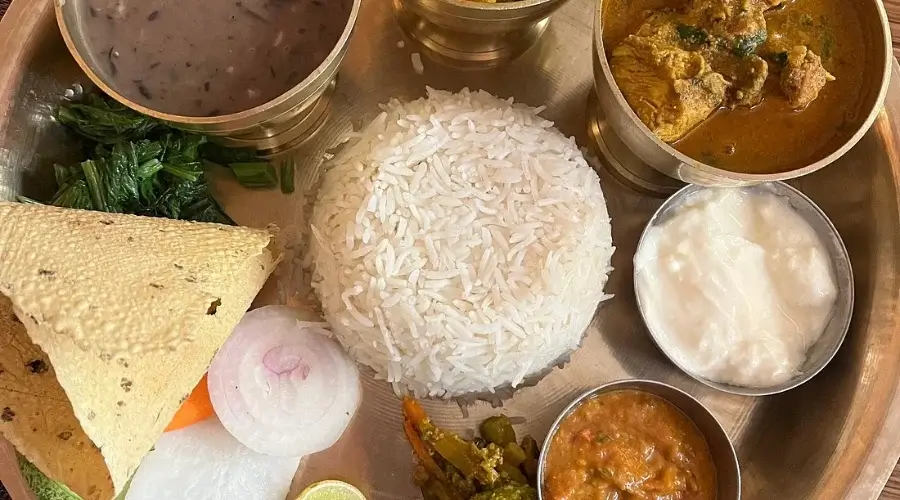
Breakfast at the teahouse on the Annapurna Circuit Trek
- Toast
- Any variety made from egg
- Porridge with milk
- Muesli
- Corn flex
- Fried potato
- Tea/coffee
- Pancake
- Tibetan bread
- Chapati and bread
- Apple and banana
Lunch at the teahouse on the Annapurna Circuit Trek
- Dal Bhat
- Noodles
- Potato items
- Pasta
- Sandwich
- Pizza
- Momo
- Fry rice
Dinner at the teahouse on the Annapurna Circuit Trek
- Dal Bhat
- Noodles
- Veg and non-veg soup and curry
- Fry rice
- Chapati and bread
- Custard, rice pudding, apple pie
- Apple and banana fitter
- Chocolate rolls
Drinks on the Annapurna Circuit Trek
- Tea
- Coffee
- Soft drinks
- Fruit juice
- Beer
- Local and packed alcohol
Dietary restrictions
All sorts of vegetarian and non-veg food can be found on the menu during the Annapurna Circuit Trek. Although, the options for vegan might be limited. The major surplus for the trek is Dal Bhat and curry, which are abundant in nutritional value. It provides enough energy required for the trek.
Moreover, for vegans, plant-based milk, tofu, or paneer might only be available sometimes. So, it might be little difficult for them.
Also, if you have any food or any allergies, please let us know so we can plan accordingly. We will make sure that the teahouses are aware of it.
Tips on Food
• Try to eat fresh and healthy food, maybe soup items, that are easily digestible.
• Pack some dried fruits, nuts, chocolates, and power bars for snacks.
• Avoid any meat items if you do not have a good digestive system.
• Usually, the teahouse owners know about foreign tastes, but let them know if you do not have spice tolerance.
• How tired you are, do not miss any meal.
Teahouses on Annapurna Circuit Trek
The teahouses on the Annapurna Circuit Trek are somewhat well-managed. They are especially better in the regions where the roadway is available.
In the majority of the trekking trails, the teahouses do not have attached bathrooms, although they might have hot showers. You might need to pay an additional fee for hot showers and other services like Wi-Fi, charging batteries, and amenities.
Though it is not guaranteed, we will try to provide you with teahouses with attached rooms.
You can find private and shared clean and warm rooms. Further, during the peak trekking season, if you are travelling solo or as a couple, you might need to share a room with others.
Usually, the dining halls of teahouses have heating stoves to keep the room warm. You can charge your mobiles in the dining hall and spend cozy time with fellow trekkers here.
The teahouses usually provide a bed and a blanket, but you might want to carry your own sleeping bag in case the blankets are not warm enough.
Tips on Accommodation
- Hot showers cost you around $2.
- You are not allowed to enter the kitchen unless you are invited.
- Charging gadgets and Wi-Fi costs you around $2-$5.
- There are no heating or charging plugs in your room.
- It is easier and faster if you order the same food if you have a large group.
Electricity & Charging During the Trek
Electricity is available in most teahouses along the route, but charging devices may incur a small fee. Carrying a power bank or extra batteries ensures your devices remain charged throughout the trek. Safe drinking water can be purchased at the teahouses or treated with purification tablets. Carrying a reusable water bottle is recommended to reduce plastic waste.
Water on Annapurna Circuit Trek
Avoid drinking tap or spring water directly without filtering or treating it. Purify the water with a water purifying tablet (a complementary water purification tablet from Himalayan Masters).
Bottled mineral water is banned in the Annapurna region, so bring your own water bottle (which is also complementary to ours). Drink at least 4 litres of water daily to keep yourself hydrated.
Group vs Private Trek
If you are a solo traveller, you can either join another group or hire a private guide. Moreover, during peak seasons (spring and autumn), private guides might not be available.
Furthermore, private accommodation is available at lower altitudes and during the off-season but cannot be guaranteed at other times. In that case, you might need to share the room with others.
For the group trek, you can have up to 7 individuals in a group. For a single group, 2 guides will be assigned. Likewise, if you have a larger group, you will be divided into groups and guides, and porters will be assigned accordingly.
Annapurna Circuit Itinerary Disclaimer
With Himalayan Masters, the Annapurna Circuit Trek is for a total of 11 days. However, the itinerary changes due to some inconsequences like weather changes, changes in health problems caused by altitude sickness, or anything like that.
Please note that the cost of accommodation and food during the trek for such an inconsequence is not handled by Himalayan Masters.
Also, Himalayan Masters customizes the trip to your needs and preferences. We can customize it to your needs, whether you are a solo trekker or have a large group.
Group Leader Description
Every trek guide leader is the backbone of a successful trek. How a leader presents and leads you through the trek will help you a lot to get to the trek’s summit. Always be present during the group leader description time.
Your group leader will describe every single detail about the trek route, the condition, the river’s name, the mountains seen during the trek and everything.
Transportation
Annapurna Circuit Trek’s major transportation is a Jeep, Scorpio, Car or bus for a large group. Himalayan Masters ensures that the best transportation for the clients is provided.
Then we need to change the transportation from Besisahar to Dharapani, so we will hire a local transportation but a private one and head towards our destination.
If you would like to feel the thrill of travelling on a local Nepali bus, we can also help you. It depends on what kind of transportation you prefer.
Why Choose Himalayan Masters for Annapurna Circuit?
Booking your Annapurna Circuit Trek with experienced guides, such as Himalayan Masters, can significantly enhance your trekking experience. Himalayan Masters employ knowledgeable and experienced guides familiar with the region’s terrain, culture, and language.
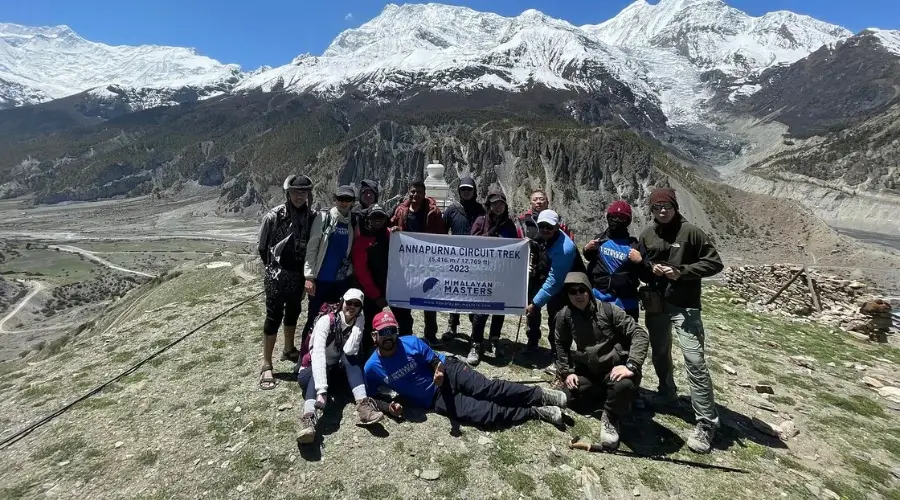
Booking/Airport Pickup
Most trekking companies offer airport pickup services in Kathmandu or Pokhara, depending on your arrival airport. When booking your trek, confirm the availability of airport pickup with your chosen trekking agency.
Support Team
A typical support team for the Annapurna Circuit Trek includes a lead guide, assistant guides, and porters. The size and composition of the support team may vary depending on the size of your trekking group.
Starting Point/Ending Point of Annapurna Circuit Trek
The Annapurna Circuit Trek typically starts in Besisahar and ends in Nayapul, covering approximately 160-200 km.
How do you book Annapurna Circuit Trek online?
To book Annapurna Circuit Trek, you will need the following documents:
- A copy of your passport
- A copy of your travel insurance
- A copy of your flight ticket
- Two passport-sized photos
- Emergency contact details
The process of booking the Annapurna Circuit Trek with Himalayan Masters is straightforward. You can check the availability of departure dates and book them from our website. Alternatively, you can contact us through the official email, [email protected].
Please visit our site to make your trek booking. Clients should note that the facilities cannot offer refunds once they have booked their services or products.
However, the amount paid for a year can be used to pay for any trek. If you cannot join, get someone else to do it because the payment is for the same trek.
7 Alternative Trekking Routes in Annapurna
- Trek to the Ice Lake at the Annapurna IV Glacier: A five-day hike with spectacular views of Dhaulagiri, Lamjunh Himal, and Fish Tail.
- Hike to Annapurna Sanctuary: A 10-day trek through snow-capped mountains, rhododendron forests, and Gurung settlements.
- Trek to Mardi Himal Base Camp: This trek opened in 2011 and offers diverse views, including Mardi Himal and Machhapuchhre.
- Poon Hill Ghorepani Trek: A shorter trek with steep climbs, ending in a sunrise view from Poon Hill.
- Trek to Lake Tilicho: A bypass from the Annapurna Circuit to the highest lake of its size in the world.
- Lower Mustang: A visit to the dry and barren region accessible by bus or flight, offering unique geological features.
- Nar Phu Valley: A remote and under-visited area between Annapurna and Manaslu, providing an adventurous trek with rugged trails and Tibetan Buddhist culture.
Annapurna Base Camp (ABC) Trek vs. Annapurna Circuit Trek
ABC Trek is less strenuous and shorter than the Annapurna Circuit Trek, which is challenging and long. It is shorter and takes one directly to the base of the Annapurna massif, where one gets to view some of the world’s tallest mountains, such as Annapurna I and Machapuchare. This trek is perfect for those who want a short one with stunning views.
The Annapurna Circuit Trek is longer and requires more physical fitness than the ABC Trek. Also, the highest altitude of the ABC Trek is 4140 meters, and the Annapurna Circuit Trek is 5416 meters, which is a lot. Both durationally and physically, the Annapurna Circuit Trek is more difficult than the Base Camp Trek.
Did You Know? Random Facts About the Annapurna Circuit Trek
- Beyond Bhulbhule lies a trout farm that exists somewhere between Bhulbhule and Bahundanda. Travelers who enjoy fresh fish will discover an appealing attraction at this location.
- One of the major waterfalls along the trail reaches its peak at 1,430 meters high, Chamje Waterfall. The site offers an excellent opportunity to pause and experience natural beauty.
- As you approach Chame, you will find Braga, which maintains Nepal’s top apple farm. A European-style apple farm stands at the location with the goal of reaching annual sales of 1 billion rupees.
- The Humde Airport in Manang operated from 1982 A.D. (2039 B.S.) until service officially ceased in 2013 A.D. (2070 B.S.). This airport remained one of the world’s highest commercial facilities. This airport has a 900-meter runway at an altitude of 3,397 meters (11,145 feet), making it the 18th highest airport worldwide. The airport receives infrequent visits from charter flights throughout the present day.
- Members of Nyeshang Valley maintain a custom of religious yak horn veneration that integrates into their cultural and spiritual traditions.
- Along the trek between Manang and Yak Kharka, you can savour Himalayan seabuckthorn juice made from sour Himalayan seabuckthorn berries that grow on thorny bushes. Sugar-sweetened Himalayan Seabuckthorn juice provides excellent energy benefits while maintaining its sweet taste.
- Persons who previously spent days travelling to Khangsar village can now use vehicle transportation through the upper reaches of the Manang district.
- Annapurna Circuit Used to Take 28 Days! The total journey to finish the Annapurna Circuit required 28 days during its peak 15 years ago. The construction of new roadways allows the journey to be finished substantially faster than before.
- In September 2023, a historical accomplishment happened when disabled trekking teams finished the Annapurna Circuit Trek using eighteen physically challenged researchers as well as twelve wheelchair users and their support personnel. The adventure proved beyond doubt that exploration knows no boundaries.
- Maurice Herzog and Louis Lachenal reached the summit of Annapurna I (8,091m) on June 3, 1950, and they became the first climbers to achieve this feat. The anniversary of this historic climb happens each year on Annapurna Day.
FAQs
What is the Annapurna Circuit Trek?
The Annapurna Circuit Trek is a long trek around the Annapurna Mountain range, covering 160-230 km, depending on the route and starting and ending points.
What is the best season for the Annapurna Circuit Trek?
Although the Annapurna trail trek is possible throughout the year, Autumn and Spring are the best seasons for the Annapurna Circuit Trek. The temperature of Annapurna from October to September and March to May is quite warm (about 15°C in the daytime), and the views are clear.
Is Annapurna Circuit trek without a guide possible?
Technically, with decent knowledge of the Nepali language, landscapes, and route, an Annapurna Circuit trek without a guide is possible. However, after recent notice from the government, you cannot trek to Annapurna without a guide. Though it is not compulsory to book a trekking package, we advise you to hire a guide for a safe, convenient, and enjoyable trekking experience.
Do I need travel insurance for the Annapurna Circuit Trek?
Yes, the Annapurna Circuit Trek requires travel insurance. As this is a high-altitude trek (above 5,000 meters), there is a risk of altitude sickness and other altitude-related risks. In worst-case scenarios, you might need helicopter evacuation, not to ignore theft and natural disasters. Therefore, it is better and a must to have travel insurance to book the trip.
What kind of hotels will we stay in?
For the Annapurna Circuit trek Itinerary, you will stay in local hotels called teahouses. The teahouses are small guesthouses made by locals and have basic facilities. Since this route was developed very early, the teahouses in the Annapurna route are already well-established. In Kathmandu and Pokhara, you will be staying in a 3-star hotel.
How can I book Himalayan Masters Annapurna Circuit Trek packages?
To book comfortable and cheap Annapurna Circuit Trek packages with us, email us or fill out our contact form on the website. We will make a specific Annapurna Circuit Itinerary per your timeline and needs. Our email is [email protected].
Then, you can confirm the trekking booking to Annapurna Circuit by paying 10% of the total amount in advance.
Do I need a Sleeping bag for the Annapurna Circuit trek?
The regions of Nepal, approximately above 3,000 meters, are cold, especially at night. Blankets and mattresses provided by the lodges and tea houses might not be enough, and heaters are also not usually available. Due to this, we suggest you carry sleeping bags with you for almost all treks in Nepal. Admiringly, our company does provide you with the facility of your very own sleeping bags for the treks.
Why is Annapurna harder than Everest?
Even though Annapurna is listed as being the 10th highest mountain peak in the world, it is still fatal and challenging to climb, even more than Everest. Due to unforeseeable weather conditions, high-velocity wind, frequent avalanches, snowfalls, falling large chunks of ice, and seracs, crevasses, and sharp ridges make Annapurna deadly, with a fatality rate of about 40%.
Can you see Everest from the Annapurna Circuit?
Because we are in two very different regions, we can’t view Mt. Everest from Annapurna Region. However, you can enjoy the views of other mountain peaks in the same region such as Annapurna I, II, III, and IV along with Machhapuchhre and Dhaulagiri.
Am I fit enough for the Annapurna Circuit trek?
If you have aerobic fitness, leg strength, and, most essentially, altitude tolerance, you are well-qualified for the Annapurna Circuit trek. It will also be easier if you have prior trekking or hiking experience. Be sure to do a complete medical analysis before the trek.
Can a beginner do Annapurna Circuit?
With appropriate preparations, a decent level of fitness, and proper guidance from your guide, it’s possible for a beginner to do Annapurna Circuit despite being a challenging journey.
Is Annapurna deadlier than Everest?
Yes, Annapurna does have a higher death rate(approx. 40%) than Everest despite being smaller in height because of the climate, sharp ridges and unpredictable snowfall, avalanches, snow-capped paths, and large pieces of ice falling through mountains.
Is Annapurna Circuit still worth it?
Of course, it’s worth it. Besides all the challenges, the feeling of accomplishment after completing the trek is simply unmatchable. The breathtaking view of mountains, hills, flora, and fauna from the trek, the experience of local cultures, and the warm hospitality of people here are once in a lifetime.
How much water do you need to carry on Annapurna Circuit?
As the altitude increases, your body might be more and more dehydrated. Hence, you need to consume 4-5 litres of water daily. However, it’s not possible to carry enough water throughout the trek. So, we suggest you carry a water bottle and purification tablets with you. You can also carry a purification bottle if available.
Can the Annapurna Circuit be done in 10 days?
It wasn’t possible earlier for the trek to be completed in 10 days. But thanks to the developed routes and paths, it can now be done in 10 days. For that, you need to drive up to Dharpani and then trek to Manang on the 4th day. Then, cross Thorang La pass on the 7th day and walk down to Jomsom on the 8th day. From Jomsom, you can drive/fly to Pokhara and then to Kathmandu.
Can the Annapurna Circuit be done in 7 days?
Yes, you can complete the trek even in 7 days. For that, you can get a Jeep from Kathmandu to Manang and cross Thorang La Pass on the 4th day. After Thorang La Pass, walk down to Jomson, and then you can either get a flight or drive to Pokhara and then to Kathmandu. But where is the beauty of trekking if you are driving throughout the journey?
Which is better Annapurna Circuit or base camp?
Even though most aspects, such as food, accommodations, permits, and seasons, are similar in both treks, the Annapurna Circuit trek provides an experience of more diverse landscapes and the roots of the local traditions and cultures around the Annapurna range. In contrast, the Base Camp trek takes you to the foot of Annapurna.
What is the age limit for Annapurna Circuit?
There isn’t any official age restriction mentioned, but children under 7-8 aren’t advised for the trek because of the challenges and the altitude.
How long does it take to complete the trek?
The trek can be completed in as few as 7 days and can be extended up to 15-20 days based on the trek customization.
What is the highest point of the trek?
The highest point of the trek is Thorong La Pass, which is 5416 meters (17,769 ft) high.
Do I need a permit for the trek?
Yes, you will need to acquire an Annapurna Conservation Area Permit (ACAP), which costs NPR 3,000 for the trek.
What type of accommodations are available on the trek?
The accommodations on the trek are basically teahouses. At Pokhara, you will be staying in a good quality hotel.
Is it safe to trek alone?
Trekking alone in the Annapurna region or any part of Nepal is safe. Theft, fighting, or any kind of clash are rare in Nepal, but they happen.
What kind of food is available on the trek?
The teahouses on the trek serve local foods such as Dal Bhat, Tibetan bread, egg items, fruit juice, pancakes, chocolate rolls, Mo: Mo, noodles, tea, coffee, etc.
How do I get to the starting point of the trek?
You can get to the starting point of the trek, Dharapani, on a private shared jeep or a public vehicle from Kathmandu.
What should I pack for the trek?
There is no fixed packing list for the Annapurna Circuit Trek. However, you might want to pack some warm clothes, trekking boots, a trekking backpack, a sleeping bag, trekking poles, sunscreen, sunglasses, thick socks, a beanie, a headlamp, medicines, etc.
Do I need to bring my own water purification method?
It is not necessary to bring your own water purification method because we will provide you with water purification tablets for the trek. Moreover, you can bring a water purification bottle if you would like.
What kind of shoes are best for the trek?
Durable, breathable, waterproof shoes with good grip are best for the trek. Salomon, Columbia, Hoka Anacapa, Merrell Moab, etc., are some of the best trekking shoe brands.
How can I prevent altitude sickness?
Proper acclimatization, staying hydrated, eating healthy food, and having positive thoughts prevent any chances of altitude sickness.
Is travel insurance necessary?
It is not compulsory to have travel insurance, but it is better to have one. Any accident could happen at any time, and in the worst case, you might need helicopter evacuation. If you have travel insurance, your expenses will be covered by the insurance.
How much money should I budget for the trek?
Particularly for the trek, you need to pay $1200, and for additional expenses, you can keep $200 to $300.
Do I need trekking poles?
It is not compulsory to have trekking poles for the trek, but having one can really come in handy for providing or reducing support for the knee.
Are there any vaccinations required?
No, you do not need any vaccinations for the Annapurna Circuit Trek. But if you have any medical conditions, consult with your doctor before going on the trek.
Can I rent trekking gear in Nepal?
Yes, you can easily rent trekking gear around Kathmandu Valley, especially around Thamel.
What should I not bring on the trek?
You should avoid overpacking for the trek. Do not overpack clothes, boots, or anything heavy. We advise you to leave your valuables at home or keep them at Himalayan Masters.
What are the daily distances covered?
In general, every day during the trek, you will need to cover 10-15 km while ascending and 20-25 km while descending.
What are the common symptoms of altitude sickness?
A person suffering from altitude sickness may experience symptoms such as headache, dizziness, nausea, fatigue, shortness of breath, loss of appetite, and difficulty sleeping.
Is there Wi-Fi available on the trek?
Yes, there is Wi-Fi available on the trek, but it might have low bandwidth, and you might need to pay an additional charge.
How cold does it get on the trek?
During spring and autumn, it might not be so cold, with temperatures ranging between 10°C and 20°C, while summer could be even warmer. However, in the higher altitudes, especially during night and winter, the region gets freezing cold, with temperatures dropping to -20°C.
Are there medical facilities on the trek?
You can find a few medical facilities just in Chame and a local health post in Manang.
Can I charge my electronics on the trek?
Yes, you can charge your electronics in the teahouses while you are on the trek. Some extra fees are levied by the teahouses for this service.
How do I deal with the lack of sanitation facilities?
The teahouses on the Annapurna circuit route are quite satisfactory. However, if you feel they are not good enough, you can carry your own toiletries and sanitary items.
What languages are spoken along the trek?
Usually, people on the trek understand Nepali and a few English words; they normally speak the Tibetan language.
What festivals might I experience during the trek?
You can experience seasonal festivals during the trek. During October, you can experience the brilliance of Dashain, while in February, you can enjoy Lhosar.
Can I interact with local communities?
The people on the trek are pretty friendly, so you can interact with local communities, though they might not understand what you say completely.
How do locals dress in the region?
Men and women dress in a long-sleeved inner shirt (wan-ju for women and wan-tash for men), with a pant-like garment made of wool, wrapped by a wraparound the waist (Bakhu), and high woollen boots in the Annapurna and Himalayan region of Nepal.
What should I do with my trash?
Do not litter around. Carry your trash and throw it away at the teahouse’s dustbin.
Are there any dangerous animals on the trek?
There are no any particularly dangerous animals on the trek route. But be careful with snow leopards, leeches, and snakes.
What should I do in case of an emergency?
Do not panic or engage in any haphazard activities in case of an emergency. Listen to your guide and be patient.
Is it safe to trek during the monsoon season?
Although the trekking trail is muddy and slippery due to rain and the dangers of mosquitoes, leeches, and other insects, it is safe to trek during the monsoon season.
What impact has tourism had on the region?
Tourism have been helping the locals in generating income by providing job opportunity, hospitality, and services. However, it has drastically impacted on the environmental degradation and cultural diversions.
What about the insurance of guides and porters?
The company provides insurance for guides and porters.
Is there a cancellation or refund policy?
No, there is no refund policy for trek packages, but the deposit you made is a lifetime deposit.
Do I need to bring my own medicines for this trek?
A few first aid medicines on the trek are provided by us, but you need to bring your personal medicines for the trek by ourself.
I am a vegetarian. Will I get enough meals during the trek?
Yes, you can get all sorts of vegetarian food, such as bread, chapati, potato, puddings, porridge, corn flex, muesli, pancakes, etc., during the trek. Moreover, you might not get everything you like.
What are the modes of transportation available in the Annapurna region?
Transportation during the trek will be either a public bus or a private jeep, as you request. Additionally, you can opt for a flight from Pokhara when returning to Kathmandu.
Are there any leeches on the trek?
Yes, leeches can be found on the Circuit trek. They thrive in damp places, so they can be found in the lower region, but as we move to higher altitudes, their number decreases.
Can I go biking during the trek?
Particularly, in the newer and lower trekking trails of Annapurna trek Nepal, biking is possible. However, the landscapes could be slippery and challenging. So, we suggest doing so if you are an experienced mountain biker.